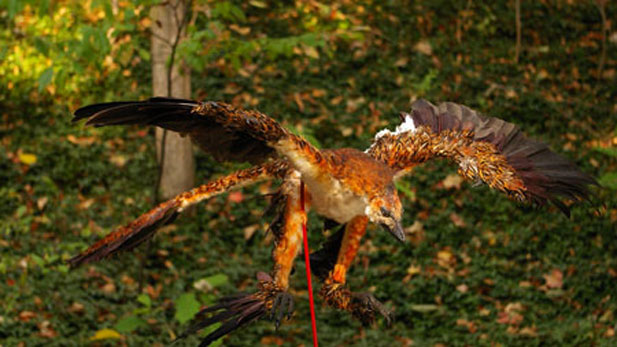Dubbed Microraptor, the crow-sized fossil is one of the smallest dinosaurs ever found and one of the most controversial, challenging conventional theories and assumptions about the evolution of flight. How did Microraptor use its wings?
Did Microraptor array its arm- and leg-mounted wings in the style of an early-20th-century biplane to produce high lift at low speed? Did it use them to create a single lifting surface for efficient, swift gliding? Did it employ some combination of these two methods? Or were the extra wings useless for flight and likely to have been for some other purpose, such as attracting a mate?
To answer these questions, NOVA interviews Chinese paleontologist Xu Xing, who first recognized the importance of Microraptor and gave it its name; paleontologist Mark Norell and artist Mick Ellison of the American Museum of Natural History; paleontologist Larry Martin of the University of Kansas; anatomist Farish Jenkins of the Museum of Comparative Zoology at Harvard University; and aerodynamicist Kenny Breuer of Brown University.
Artists have historically played an important role in paleontology by helping to reconstruct the appearance and behavior of ancient animals. In the case of Microraptor, two completely different reconstructions were made, one at the American Museum of Natural History and the other at the University of Kansas, based on different specimens and different techniques.

In addition, NOVA commissioned a “flight-ready” wind tunnel model of Microraptor, complete with feathers and articulating joints.
The different reconstructions play into a long-running scientific controversy over the origin of flight in birds. For years the debate has been a standoff between two camps — those who believe dinosaurs were the ancestors of birds and those who don’t.
Believers in the dinosaur-bird connection have generally assumed that flight must have begun from the ground up, with fast-running dinosaurs that eventually went airborne as feathered arms evolved into wings and running leaps evolved into powered flight.
Skeptics of the dinosaur-bird link say it would have been physically impossible for running dinosaurs to overcome gravity and get off the ground. It made more sense for flight to evolve from the trees down, with small, arboreal reptiles that glided from the treetops on their way to becoming full-fledged fliers. And that seemed to rule out dinosaurs, which, presumably, couldn’t climb trees.

By submitting your comments, you hereby give AZPM the right to post your comments and potentially use them in any other form of media operated by this institution.